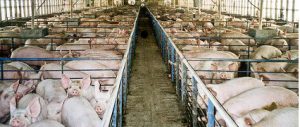In recent months, a fierce drought has gripped much of China. It has now eased somewhat, but Shandong, a grain-producing province in eastern China, was the driest it had been in 200 years. Not only the wheat harvest, but also millions of farmers’ livestock and livelihoods were put at risk.
As global greenhouse-gas emissions rise, such droughts are likely to become more severe and more frequent – in China, as elsewhere. So, how can the country become more resilient? One solution exists in China’s booming livestock sector.
China has surpassed the United States to become the world’s top producer of meat chickens (many billions annually) and pigs (more than 700 million each year). China also has 92 million cattle – one of the world’s largest herds – and raises two-thirds of the world’s domestic ducks and 90% of geese used for meat.
As it industrialises, China’s livestock sector puts additional pressure on water and land resources, and helps to fuel climate change. If it expands and further intensifies, these pressures will only increase.
At the end of March, I spent a week at universities in Beijing and Shanghai speaking about the global livestock sector and climate change. For many, the data and issues I presented were not widely known. “The climate change issue concerns everyone on the planet,” said Lin Weiqing, deputy director of the Shanghai Academy of Environmental Sciences. But looking at the issue from the perspective of agriculture was, he continued, a first for him. “With this new information, we should do something,” he said. “Maybe the conclusion is: eat less meat and plant more trees.”
A number of professors, students and even a few policymakers in Beijing and Shanghai agreed with the importance of the connection between livestock, climate and food security. Others were more sceptical: wary about the economics, how this fits with the national priority of low-carbon development or convinced of the importance of meat in one’s diet.
“It’s a global, capitalist economic system,” one professor in Shanghai told me. “We need to [adopt the intensive production model],” he continued. “If we don’t, we’ll lose out.” He agreed, however, on the need to account for the externalities of intensive livestock production, including greenhouse gases, water pollution and land degradation. Another professor in Beijing declared that while Americans may be fed up with eating so many animal products, that wasn’t the case in China.
However, several students from Fudan University, who attended the presentation at the Shanghai Academy of Environmental Sciences, have decided to research – for the first time – the greenhouse-gas emissions produced by China’s livestock sector. I am glad they will, because challenges – as well as opportunities – for China abound.
Over the past three decades, China has done an impressive job of ensuring national food security. However, intensification of animal agriculture means that “the livestock sector enters into more and direct competition for scarce land, water, and other natural resources”, according to the United Nations Food and Agriculture Organization (FAO).
China now allots approximately 28.5% of its grain to livestock feed, more than double the amount 30 years ago. There is an inherent inefficiency here: between two and five times the amount of grain is required to produce the same number of calories through livestock as are needed when grain is eaten directly by people (and as much as 10 times for industrially-produced beef), research by Rosamond Naylor, professor of environmental earth system science at Stanford University, estimated.
Raising livestock is also water intensive: 29% of the “water footprint” of the global agricultural sector is “related to the production of animal products”, concluded a recent study by the United Nations Educational, Scientific and Cultural Organisation (UNESCO). Researchers found that 98% of the water consumed by the livestock sector is used in the production of feed grains, including corn, soybeans and wheat.
China uses 455 cubic metres of “blue water” (surface and groundwater) and 839 cubic metres of “green water” (rainwater that isn’t runoff) per tonne of wheat converted into livestock feed. While China’s wheat for feed “water footprint” is not the highest of those countries UNESCO measured (the highest is Australia), it is larger than that of India, Germany and Egypt.
The green water required for corn used for livestock feed in China is 791 cubic metres per tonne – below the world average, but well above the US level of 523 cubic metres per tonne of corn. The more feed an animal requires, the larger the water footprint. In general, the researchers found that animal products have larger water footprints than crops do.
The UNESCO report also concluded that “. . . animal production and consumption play an important role in depleting and polluting the world’s scarce freshwater resources.” This, too, is a Chinese reality.
Last year China released its most stringent survey of water pollution and found levels much higher than reported in previous research, which hadn’t counted many agricultural pollutants. Run-off was 13.2 million tonnes – nearly equal to the previous total, which, excluding pesticides and fertilisers, found 13.8 million tonnes of discharges polluting China’s waterways.
The drought this year has also drawn attention to the rapid loss of agricultural land. China has only one-third of the world’s per capita average of available arable land, and the 122 million hectares remaining is just 1.8 million hectares above the minimum estimate of what’s needed to ensure China’s food security.
Of that land, 50 million hectares of farmland and 400 million people, nearly one-third of China’s population, are affected by erratic weather each year. There’s a connection to livestock here, too. The sector is a major source of greenhouse gases, responsible for at least 18% of total emissions worldwide, according to the FAO. (Another study published by two World Bank environmental specialists in the magazine of the US-based Worldwatch Institute, put the level much higher, at 51%.) China is the world’s largest source of methane from manure, emitting roughly 3.84 million tonnes in 2004—more than one-fifth of the global total.
International markets have been rattled by the possible consequences of a failure of the harvest in the world’s largest wheat producer. Within China, the cost of food has been rising for months. The World Bank warned recently that global food prices are at “dangerous levels”. The underlying trends – including erratic weather and rising demand for and production of livestock products – suggest that the price of food, along with food security, will remain global concerns.
The UNESCO report states that “in countries where the consumption of animal products is still quickly rising, one should critically look how this growing demand can be moderated.”
A recent greenhouse-gas inventory by the Low-Carbon Energy Research Centre of the Shanghai Academy of Environmental Sciences found that, in Shanghai, greenhouse-gases from agriculture, including large livestock facilities within the city limits, were rising. They will be responsible for a larger portion of Shanghai’s ecological footprint in coming years.
Drought, resource scarcity and food insecurity are urgent domestic and international problems. China has the opportunity to take a bold step—and create, instead of a “meat world”, a more sustainable, humane food system. Such measures would fit well within the low-carbon economy framework China has adopted for future economic development.
This doesn’t mean consigning a majority of Chinese citizens to the “enforced vegetarianism of poverty”, but rather orienting the agricultural economy toward supplying varied, nutritious, safe and plant-centred foods to all Chinese. This could be a model for the rest of the world too.
Mia MacDonald is executive director of Brighter Green, a public-policy action tank based in New York. She is also a senior fellow of the US-based Worldwatch Institute and an adjunct faculty member in New York University’s environmental studies programme.
Homepage image from gyhgyh


